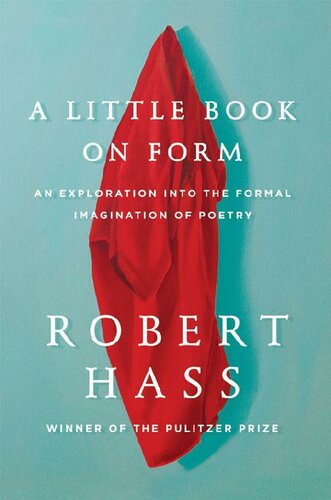
A Little Book on Form
An Exploration into the Formal Imagination of Poetry
کتاب های مرتبط
- اطلاعات
- نقد و بررسی
- دیدگاه کاربران
نقد و بررسی

February 6, 2017
With specificity, clarity, and inspired insight, Hass (Times and Materials), a Pulitzer Prize winner and former U.S. poet laureate, painstakingly dissects and analyzes poetic form. Hass’s reading is extensive, as shown by references to and quotations of dozens of poets, ranging in period from Caesar’s Rome to the Renaissance and 21st-century America. He includes the greats—Bashõ, Dickinson, Rudaki, Shakespeare—and a wealth of lesser-known talents. Hass discusses how poetic form synthesizes many subjects, including math, music, religion, and sexuality. Throughout, he justifies and asserts the place of order in poetic form, which is often accused of being chaotic and abstruse. The first fourth of the book alone is dedicated to the significance of line count. He instructs that a single line is whole, in addition to being “light and heavy”; that two lines introduce dependent relation and can be seen as an aspect of one; and that three lines, due to their lack of symmetrical relation, evoke mystery and infinitude. He also includes intriguing etymologies and translations, delineating the evolution of specific words, poems, and poetic forms. Hass has produced an emotionally and intellectually nurturing work of analysis, suited for academia and ambitious leisure readers.

Starred review from February 1, 2017
What makes a poem tick.Weighing in at more than 400 pages, this hefty book on poetic form is anything but little. It's an impressive accomplishment by Pulitzer Prize and National Book Award winner and past U.S. Poet Laureate Hass (English/Univ. of California; What Light Can Do: Essays on Art, Imagination, and the Natural World, 2012, etc.), who is one of only a handful of contemporary poets who could even think of taking on such a monumental task. As he notes in the brief introduction, this has been a work in progress for two decades. His modest goal is to explain how the "formal imagination actually operates in poetry," the "way the poem embodies the energy of the gesture of its making." Hass begins with analyses of a single line, then two, three, and four, which take up the book's first 100 pages. Next, he moves on to form (blank verse, sonnet, etc.) and genre (ode, elegy, satire, prose poems, etc.), finishing up with stress and rhythm. Along the way, he draws on hundreds of examples of lines, stanzas, and complete poems from the history of poetry, which he carefully selects to illustrate his points. There are also hundreds of asides, lovely little insights, and strong opinions. The first sonnet on a political theme is by Milton. Ted Berrigan's book-long Sonnets "tries to get something of Jackson Pollock's method...coming at you." Other topics: what are the four best villanelles? Who wrote the best pantoum? Answer: Donald Justice. And, the "American prose poem in English probably begins with Gertrude Stein's Tender Buttons (1914)." There's much fodder here for poet lovers to discuss and debate. Look for this book on the short shelf of classics that includes Annie Finch's An Exaltation of Forms and Eavan Boland and Mark Strand's The Making of a Poem. Erudite, witty, and well-informed, this encyclopedic labor of love will become the go-to book on poetic form for years to come.
COPYRIGHT(2017) Kirkus Reviews, ALL RIGHTS RESERVED.

March 1, 2017
Pulitzer Prize-winning poet Hass (Distinguished Professor in Poetry and Poetics, Univ. of California, Berkeley; Time and Materials) has assembled a polished version of his notes and thoughts since 1995 regarding the existence and use of form in poetry. He begins by analyzing single lines of poetry, eventually building on that by adding additional lines until he is writing about four-line stanzas. Throughout this study, the author explains the history and circumstances of the forms that he is evaluating as well as the significance of the syllables and patterns that make up a poem. He uses examples from many different types of verse (sonnets, haiku, etc.) and cultures all over the world in order to show the connections among poems, types of poetry, and how a poet may have improvised to create something unique. VERDICT This book is for readers curious about the history or analysis of literature, and especially for library collections focused on poetry and poetics. [See Prepub Alert, 10/31/16.]--Jeremy Spencer, Univ. of California, Davis, Law Lib.
Copyright 2017 Library Journal, LLC Used with permission.

April 1, 2017
There is nothing little about this intricately informative and inspiring master class on poetic forms. A distinguished poet and scholar with a global literary fluency and a passion for sharing his knowledge and awe, Hass (What Light Can Do, 2012) establishes the traditional rules for composing sonnets, villanelles, and other forms based on a precise number of lines and other fixed elements, but what he hopes to address is the formal imagination that is, the creative force fueled by emotion and intuition that brings poetry to life. He constructs his guide sturdily, beginning by examining one line as the basic gesture of a poem, then moving on to stanzas and blank and free verse, all the while tracking the evolution of forms over time and providing powerful examples by a thrillingly diverse range of poets ancient and modern. Hass then shifts from structure to genres and subjects, analyzing lyrics, odes, elegies, and more in erudite yet conversational commentary. Form meets the artistic spirit in this zestful and invaluable mix of lucid instruction and vibrant anthology.(Reprinted with permission of Booklist, copyright 2017, American Library Association.)

























دیدگاه کاربران